
Dual Purpose ST
The stars have aligned, the bank account is healthy; it’s finally time to fulfill your dreams and buy a boat. Both cruising and racing are part of your plan, but owning two boats isn’t. How do you decide what kind of boat to buy? We spoke with dealers from all around the United States, all of them with decades of experience in the marine industry, and all carrying a few of the most popular brands in the country. Their experience and collective wisdom should help you find a boat, new or used, that best fits your needs.A savvy boat dealer will assess what a buyer is looking for before he or she shows them any boats or takes them on a test sail. “What we try and do is play a game by drawing a line with one side being a pure cruiser and the other a pure racer,” says Garth Hichens, owner of Annapolis Yacht Sales, Md. “Then we try to find where they are in the middle of that. It’s not as though there’s a line in the middle that’s racer/cruiser, it’s more of a wide band. I talk to them and find out where they fit.” Prospective buyers can help facilitate this process by first coming up with a simple “pros and cons” list. According to Jeff Trask, owner of Sail California, which sells J Boats in Newport Beach, the first question you should ask yourself is: What is the most important thing you’re going to do on a sailboat? “Then we take a look at the size of the family and the budget,” says Trask. “You can cruise on anything, and you can race on anything, but it’s a lot easier to race anything than it is to cruise anything.”Don’t make the mistake of going solo. As with any other major financial decision, your significant other-and maybe even your kids, if they’re old enough-should be part of the process of figuring out which boat best suits your needs. Of course, sometimes neither the wife (or the husband) nor the kids want anything to do with boating. You’ll be the exception, but making the decisions might be easier and take less time.Cruising boats outsell racing boats by a huge margin in the U.S., but it’s become a lot easier to buy a true dual-purpose boat today and be satisfied with its performance in both disciplines. “New boats sail much better than boats used to,” says Bump Wilcox, owner of New Wave Yachts, in Marblehead, Mass. “They sail higher and faster. You can make a decently stiff boat that doesn’t need people sitting on the rail. ” Last year, Wilcox cruised and raced one of the boats he carries, a Sabre 382. “We raced it a lot and did well,” he says. “That’s certainly a boat I wouldn’t be embarrassed cruising on; it’s a cruiser/racer not a racer/cruiser, but I put a carbon rig and good sails on it and we beat some flat-out raceboats.””On the race side in particular, what I’m seeing is the customers buying these boats are looking at sail dimensions, power ratios, and displacement-to-length ratios,” says Dan Krier, a partner in the Marine Service Center in Seattle and Anacortes, Wash., which carries the C&C, Jeanneau, and Elan lines. “They’re looking at the handling, asking how big the headsail is. People are getting away from boats that take an army to crew and getting into smaller crews. That way it’s easier to get out on the racecourse because it’s easier to find crew. With carbon rigs, the weight aloft is reduced and one can get away with less righting moment.”And so, with the dual-purpose intention, what are the attributes a racing sailor should be weighing? Let’s start at the bottom with the keel. “In a cruiser/racer you would have a little bit of a debate between a traditional fin keel and a wing keel,” says Wilcox. “I think that for any type of performance, wing keels are hopeless.” Racers want deep fins, cruisers want to gunkhole in shallow water. A T-bulb keel might best satisfy the center-of-gravity needs of a grand-prix racer, but it’s not easy to get a lobster trap line off of one. The right keel is the one that works best for the type of sailing you plan on doing. For all-around usefulness, a fin keel with an aft-swept bulb can do the trick.Cockpits are where a lot of a boat’s action, either on the hook or on the racecourse, takes place. Our dealers recommend features such as removable stern lockers and tables, and high cockpit coamings for comfort and bluewater safety. Twin wheels make it easier to transit the cockpit, and they give the helmsman excellent visibility. “Typically, a wife’s objections to cruiser/racers is the traveler in the cockpit,” says Krier. “The traveler in the cockpit makes the table in the cockpit more complicated. We work around that because we eliminate objections. We put a quick-release shackle on the mainsheet system. You pop it off and bring it over and cleat it to the toerail. In the case of the C&C 115, you’ve got a Wichard padeye for the spin gear, which we attach the mainsheet to. Then you take a teak cockpit table that sets up on the binnacle and now you’ve got the dining experience.” “If a customer wants to do both racing and cruising,” says Krier. “The owner will typically have a symmetric spinnaker to race with, so he can drive the boat deep and get those good VMG angles. Then, for cruising, he buys an asymmetric spinnaker. All we do is take the downhaul, and rather than running it up to a pole, we take it out to a block at the pulpit, and that’s your tack line.” It’s also getting easier to satisfy everyone’s comfort wishes. Better batteries and charging systems, and lighter, more efficient equipment (think flat-screen TVs) make it possible to equip boats with the extras that making cruising (and distance racing) less arduous. “In the last 30 years there’s been a dramatic increase in systems,” says Wilcox. “Inverters are more efficient, but we’re typically putting six-plus batteries in boats. We’re finding lots more appliances on board that five or six years ago we couldn’t do, energy-wise.”What about used boats? Look for a boat with a proven history in PHRF racing, by far the most popular racing rule among U.S. sailors. Construction is important, too. Older boats with cored hulls and decks should be rigorously inspected by a surveyor before any offer is made. Some boats that are popular now have been around long enough to start appearing on the used-boat market. Good examples are the Beneteau 36.7, the C&C 99, and the J/120. The Beneteau is solid glass, the C&C 99 has an epoxy hull, and the J/120 is made with J Boat’s proprietary SCRIMP system. All of these construction methods offer longevity.









